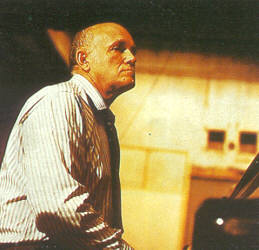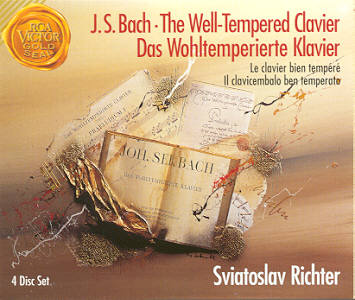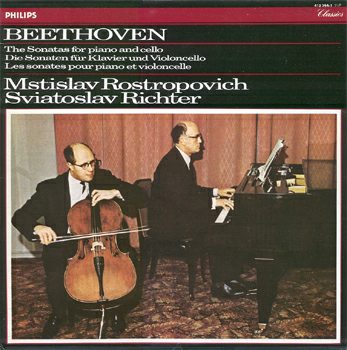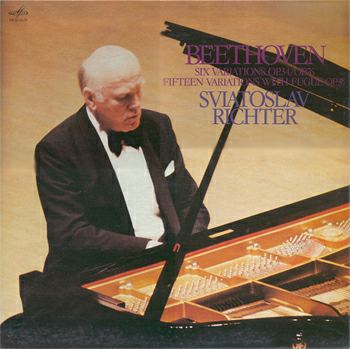* RICHTER, Sviatoslav(20th Mar. 1915 ~ 1st Aug. 1997)
[ The holy devil, or satanic angel? ]
 [ Left Photo
] Sviatoslav Richter
[ Left Photo
] Sviatoslav Richter
If we have to evaluate all the pianists regardless of the personal tastes, there will be several creteria like the width of repertoire, technique, and individuality, etc. I think there is the only one that can be chosen in top 3 by any respects, Sviatoslav Richter. His strongest 'competitor' is perhaps Vladimir Horowitz, but a critical drawback is the width of repertoire. Other Austro-German pianists like Backhaus, Rudolf Serkin, and Kempff are not comparable to Richter in this respect, too.
Sviatoslav
Teofilovich Richter was born in Zhitomir, in Ukraine. His
family resided in Zhitomir from his grandfather, and his
father(Teofil) learned piano and organ in Vienna
Conservatory and taught piano at Zhitomir and Odessa
Conservatory. He married one of his pupil. But our young
Slava did not learn much from his father. He almost
taught himself. We can't know the exact reason, but I
guess there are some clues in Heinrich Neuhaus's 'The Art
of piano playing'; Famed piano teachers are so busy
teaching his pupils as to have little time for their own
children. Anyway, we can hear of Slava that he can play
Liszt's work at 16, and the most complex orchestral
scores(e.g. Wagner) at first sight. He was enough to be
called a real genius.
He began the
legendary musical life only at 19 at Odessa by a Chopin
program, which was a great success though he remembered
not very good. He came into the Odessa Opera as a Korrepetitor,
making use of his immense capacity of playing orchestral
score at first sight. Many peoples say he was an
assistant conductor in these age, but it is completely
wrong. (See my record error page)
One day, a friend of his recommended him
that he should go to Moscow Conservatory. Heinrich
Neuhaus, a legendary teacher, reminded the encounter ;
"entered a young and thin man, played piano
wonderfully. I thought he must be a genius, and accepted
him as a pupil at once." The young Slava studied
with Neuhaus for 10 years. Slava was already completed as
an artist then as Neuhaus said "He makes a nearly
perfect interpretation as soon as he sees a work. I have
never seen any other pianist that has wider artistic
horizon than him." However, Neuhaus gave a
significant influence on him without doubt, judging from
the fact that Richter said "Neuhaus made me a
pianist".
Richter's family history is often on his fan's tongue. HIs father was killed by Beria's NKVD(later KGB) only because he has German origin after the 'Barba Rosa' operation. His mother formally married an acquaintance, moving to Germany following the retreating German army. At Moscow, Slava received the news that his mother was dead. But his mother heard a radio broadcast of her son in West Germany, and was able to see her son in 1960 after the legendary Carnegie Hall debut. How happy ther mother and the son were! And, Slava 'married' Soprano Nina Dorliac(1908~1997) in 1946. They never declared the marriage publicly, but Nina was accompanied by Slava at her every recital, and she had been with him at all of his concert journey. Of course, they lived at a house, apartment in Moscow.
 Slava's
Moscow official debut concert was in 1940 by the sonata
No.6 of Serge Prokofiev, who himself chose Slava's
playing. He praised Richter, "He makes my works
totally new" (we should remember an episode that
Prokofiev stopped David Oistrakh's playing because he did
not think it was good enough) Later, Richter premiered
his sonata No.7 and No.9(No.8 was premiered by Emil
Gilels), and the latter was dedicated to Richter. His
Prokofiev recordings at the labels of Melodiya, EMI, and
DG show the best of him and are considered as one of the
typical interpretations of Prokofiev.
Slava's
Moscow official debut concert was in 1940 by the sonata
No.6 of Serge Prokofiev, who himself chose Slava's
playing. He praised Richter, "He makes my works
totally new" (we should remember an episode that
Prokofiev stopped David Oistrakh's playing because he did
not think it was good enough) Later, Richter premiered
his sonata No.7 and No.9(No.8 was premiered by Emil
Gilels), and the latter was dedicated to Richter. His
Prokofiev recordings at the labels of Melodiya, EMI, and
DG show the best of him and are considered as one of the
typical interpretations of Prokofiev.
After the WWII, his fame began to be spread behind the iron curtain. He won the first prize at All-Soviet Concour, and was praised as 'the Liszt of our time' at 'Spring of Prague' festival. But in the Western world, only rare LPs of Melodiya was known, though Gilels declared "Wait for Richter" at Paris in 1955. Richter was not in the Soviet's best artists including Oistrakh and Gilels, of the 1955 Western tour. It was Van Cliburn and Glenn Gould that decisively informed Slava of the Western music world. Van heard Richter's playing at the Moscow, in the famous 1957 Tchaikovsky Concour visit. He said "The most powerful playing I have ever heard". Gould also entered one of the Richter's recital in his 1957 Moscow tour. Richter began by Schubert's Sonata No.21, of which the Melodiya 1971 recording shocked the listeners by the extremely slow tempo of the first movement. Gould remembered the concert as "the moment I saw the best interpreter of music that our age had borne".
The legendary impresario Sol Hurok tried to contact Slava from then on, but his American tour was realized only at 1960. HIs first concert program in Western world was Brahms's concert No.2 with the Chicago Symphony conducted by Erich Leinsdorf. It was an amazing success, and the successive concerts at the Carnegie Hall firmly settled his fame. Critics unanimously praised his technique and music, especially were surprised at his Beethoven. From 1961, he toured the Western Europe, and it was also a succession of great triumphs. He was praised as one of the great pianists of the 20th century from then on, as the same rank with Backhaus, Horowitz, Rudolf Serkin, and Artur Rubinstein.
They say his personality was very affable, but that not normal. He met the demonstration against Soviet's invading Czeko at USA in 1968. He said "Why must they intervene the politics to the art?" and never played in USA again. Richter was in juries of the 1957 Tchaikovsky concour. He gave the 100 points to Van Cliburn though the full was only 10 points. After the 'accident', no suggestion of concour jury was given to him.
He toured all over the world including Japan and Korea. I was lucky to be at the concert of his Seoul recital on 20th April 1994, programmed Prokofiev, Scriabin, and Ravel. It was undoubtedly the best concert I have ever heard from now on. He did not exile to Western World from the the Soviet regime, but lived most of his late years in France. He returned to Russia shortly before he died, and passed away by heart attack.
2. The art of Richter
 It is next to impossible to define Richter's
artistry by a word. He is a camelleon, and shows totally
different face as the repertoire. Such a many face is unprecedented even in
the best pianists. I think only Artur Rubinstein is near
him at this capability, but that Rubinstein almost could
not defy J.S.Bach(except for only Bach-Busoni's
Chaconne). Often noted, who except Richter can play the
Well-Tempered Clavier and Tchaikovsky's Piano Sonata
equally well? I can imagine no intersection between his
warm Bach and Tchaikovsky's motor-like impetus. Even his tone is a camellon
by the recording label and concert hall, too. Though chosen in the recordings of
the similar dates, the tone of Schumann's Fantasy and
Beethoven's Tempest(EMI, 1961) is round, that of the
Liszt's concertos(Philips, 1961) brilliant, and that of
the extracts of Bach's WTC(DG, 1962 live) warm and
diffusive. More examples are that of Brahms's concerto
No.2 with Leinsdorf(RCA, 1960; hard and concentric), and
of Schumann's Symphonic Etude(Melodiya, 1971; shockingly
powerful, mature, and somewhat 'cool'). Compared to
Backhaus, Kempff, Horowitz, and Rubinstein, Richter's individuality is
NOT his tone. It's clear. [
After Bruno Monsaingeon's book, he never chose piano and
said "When I am well, I can find my tone easily at
any piano, but not well I can't." I was able to
understand why his sonority was so various. ]
It is next to impossible to define Richter's
artistry by a word. He is a camelleon, and shows totally
different face as the repertoire. Such a many face is unprecedented even in
the best pianists. I think only Artur Rubinstein is near
him at this capability, but that Rubinstein almost could
not defy J.S.Bach(except for only Bach-Busoni's
Chaconne). Often noted, who except Richter can play the
Well-Tempered Clavier and Tchaikovsky's Piano Sonata
equally well? I can imagine no intersection between his
warm Bach and Tchaikovsky's motor-like impetus. Even his tone is a camellon
by the recording label and concert hall, too. Though chosen in the recordings of
the similar dates, the tone of Schumann's Fantasy and
Beethoven's Tempest(EMI, 1961) is round, that of the
Liszt's concertos(Philips, 1961) brilliant, and that of
the extracts of Bach's WTC(DG, 1962 live) warm and
diffusive. More examples are that of Brahms's concerto
No.2 with Leinsdorf(RCA, 1960; hard and concentric), and
of Schumann's Symphonic Etude(Melodiya, 1971; shockingly
powerful, mature, and somewhat 'cool'). Compared to
Backhaus, Kempff, Horowitz, and Rubinstein, Richter's individuality is
NOT his tone. It's clear. [
After Bruno Monsaingeon's book, he never chose piano and
said "When I am well, I can find my tone easily at
any piano, but not well I can't." I was able to
understand why his sonority was so various. ]
If his charm is not the 'individual tone',
what makes his playing so attractive? Of course, his
boundless and transcendent technique(he is said to
exercise 7 hours a day even when travelling) or nearly
fanatic(and irresistibly magnetic!) atmosphere of the
1958 Sofia recital may be mentioned. However, (though there are many
exception) I think it results from 'the ability to look
into ALL of the work' and 'piercing self-claim, and the
power expressioning it'. Neuhaus
said "When listening his playing, we can look down
the total works... He has a horizontal vision,
that reaches all of the works to a far distance".
His penetrating ability of a work can be easily seen at
Beethoven's Appassionata recording by RCA(1960). 1st
movement is slow, but full of tension. 3rd movement is
fluent rapidly, and almost most madly furious and
toughest at the coda(Presto) in all the recordings I have
ever heard. Neuhaus once said "The first movement of
Appassionata sonata tends to be played too rapidly",
and his two famous pupil Gilels and Richter played it
relatively slowly - Gilels's DG recording is similar to
Richter's in tempi. Richter's tempi give more impressions
than 'only fast and furious'. (Only in tempi, Gulda's 1967 Amadeo recording is much faster in
1st movement.) Richter's essence(or attractiveness!) is
choking excitement and orgasm, which captivates the
audiences. Tempi goes faster and faster - it makes music
'driving' impetus. Moreover, many would be puzzled at the
faster-than-bullet coda(only Gulda is comparable in
tempo). At the legendary Carnegie Hall live 1960, the
performance is said to be more pressing and
magnetic(Columbia LP-released but Richter himself asked
it deleted from catalogue). Well, how was the music?
His another face can be seen at the complete
cello sonata with Rostropovich(Philips). At this
recording, Richter is more eminent than Rostropovich.
Slava's technique is perfect, music very concentric, and
his claim well-balanced with Rostropovich's (too big)
scale. Richter's 'complete recording' is only 2
works(another is only Bach's WTC). The recording sessions
are about 2-year-long, but all of the 5 works are at very
high level. Undoubtedly, his piano part is inferior to no
other pianist.
 In the solo works, Bach's WTC is one of the
representative recording of his. But I think the
bomb-like Schumann's Symphonic Etudes is better to know
his personality. His Schubert is sometimes disputable,
but Schumann nearly unanimously praised, which I agree
to. This hard-boiling pianist totally controls Schumann's
capricious frames, and freely makes use of his power on a
large scale. Other recordings are concerto with
Matacic(EMI) and Sanderling(DG), Fantasy(EMI), Sonata
No.2, Papillon, Jests from Vienna(EMI, live), Humoreske
and extracts from Fantasy pieces(Melodiya), Abegg
variations, Novelleten, Toccata(DG), Various works
op.99(Melodiya), etc. Any of these are near must.
In the solo works, Bach's WTC is one of the
representative recording of his. But I think the
bomb-like Schumann's Symphonic Etudes is better to know
his personality. His Schubert is sometimes disputable,
but Schumann nearly unanimously praised, which I agree
to. This hard-boiling pianist totally controls Schumann's
capricious frames, and freely makes use of his power on a
large scale. Other recordings are concerto with
Matacic(EMI) and Sanderling(DG), Fantasy(EMI), Sonata
No.2, Papillon, Jests from Vienna(EMI, live), Humoreske
and extracts from Fantasy pieces(Melodiya), Abegg
variations, Novelleten, Toccata(DG), Various works
op.99(Melodiya), etc. Any of these are near must.
The next recommendable records are
Beethoven's sonatas of early and middle age, recorded at
many label(RCA, Philips, EMI, Melodiya, etc.). Except his
latest year recordings, all powerfully appeal Richter's
individuality and power. I cannot miss Schubert's
sonatas. Wanderer Fantasy and No.13 D.664(EMI) have
already settled as a reference, and many recordings -
Nos. 9,11,13~17,19,21(Melodiya), No.18(Philips) - made
him a pioneer and expert of Schubert. In special, I
recommend No.17 and 21, and the latter would puzzle
everyone. Beethoven's variations(Melodiya) and Diabelli
variations(Philips, live) also good.
I want to note his next concerto recordings
- Brahms No.2 with Leinsdorf(RCA), Rachmaninov No.2(DG),
Beethoven's Triple concerto(EMI), Liszt's Nos. 1 &
2(Philips), Grieg(EMI), Brahms No.2, Bartok No.2,
Prokofiev No.5(EMI, all with Maazel), Dvorak(EMI). All of
them are individual and representative ones of the same
works, which will satisfy you enough. The famous
Tchaikovsky No.1 with Karajan(DG) is not favored by me -
I prefer Gilels or Horowitz because I think the grandeur
extravaganza is the essence of this work. More notable
concerto recordings are Bach No.1(Melodiya), Beethoven
No.1(2 times with Munch, Eschenbach; RCA),
No.3(Sanderling/DG, Muti/EMI), Glazounov, Prokofiev No.1,
Saint-Saens No.5(Melodiya), Schumann, Prokofiev No.5,
Mozart No.20(DG), and No.22(EMI).
![]() His live
recordings are very highly acclaimed. Frankly speaking,
they appeal his ebulliant face. I want to hear his
legendary Carnegie Hall debut(Columbia), which were
deleted from LP catalogue by Richter's intention. But the
1958
Sofia recital(Philips)
is on catalogue. The sound is never good, but the music
is burning the concert hall by its overwhelming power and
tension. Though not solo, the successive lives with David
Oistrakh at the grand
hall of Moscow conservatory between 1968 and
1972(Melodiya) are one of the best live recordings I have
ever heard. Especially in them, the Franck's sonata on
1968 is undoubtedly the top in the parallel fusion of the
two players, tension, and vast scale. His self-control
and feelings about intuition made the performance
successful in both concert hall and record. Who can
darely defy music comparable to him? His 'defying
spirit'(not only in repertoire) is worth while to a
monument to any present pianists. I recommend the lives
with Borodin SQ - Brahms's quartet No.2, and Dvorak's 2
quintets(Philips).
His live
recordings are very highly acclaimed. Frankly speaking,
they appeal his ebulliant face. I want to hear his
legendary Carnegie Hall debut(Columbia), which were
deleted from LP catalogue by Richter's intention. But the
1958
Sofia recital(Philips)
is on catalogue. The sound is never good, but the music
is burning the concert hall by its overwhelming power and
tension. Though not solo, the successive lives with David
Oistrakh at the grand
hall of Moscow conservatory between 1968 and
1972(Melodiya) are one of the best live recordings I have
ever heard. Especially in them, the Franck's sonata on
1968 is undoubtedly the top in the parallel fusion of the
two players, tension, and vast scale. His self-control
and feelings about intuition made the performance
successful in both concert hall and record. Who can
darely defy music comparable to him? His 'defying
spirit'(not only in repertoire) is worth while to a
monument to any present pianists. I recommend the lives
with Borodin SQ - Brahms's quartet No.2, and Dvorak's 2
quintets(Philips).
In the late years, Richter preferred the small hall or museum to the great hall. Because of his health and capricious frame, he often canceled the concert schedule. The concert-goers had to know the programs only by the concert pamphlet. He always tried to enhance his playing, and always full of the 'unsatisfaction to the performance of his own'. Therefore someone said him as 'The holy devil'. However, I don't agree with this. Sometimes he emphasized the other side of the music - ebulliant and fanatic, but changed it to the heavenly peaceful atmosphere shortly after. I want to suggest his nickname should be 'The satanic angel'.
Links
 Paul Geffen's Sviatoslav
Richter Memoriam
; The supreme homepage dedicated to Richter.
Overwhelming. I wanted to make Richter's
discography myself, but only linked because this
is wonderful and I cannot make it at this level.
The background image of the top page is Richter's
tomb at Moscow. (I sent him an approval mail
for quotation of several anecdotes, but he never
replied. Therefore, I had no choice to go along
without his permission in making this page)
Paul Geffen's Sviatoslav
Richter Memoriam
; The supreme homepage dedicated to Richter.
Overwhelming. I wanted to make Richter's
discography myself, but only linked because this
is wonderful and I cannot make it at this level.
The background image of the top page is Richter's
tomb at Moscow. (I sent him an approval mail
for quotation of several anecdotes, but he never
replied. Therefore, I had no choice to go along
without his permission in making this page)- Heinrich Neuhaus's page ; This wonderful musician and able teacher took very much influence on younger generations of Russia. Also including Nina Dorliak's biography.
(c) 2001~ , Youngrok LEE ; Link free, but please get my approval before you reuse, copy, or quote this materials.
Created ; 3rd Aug. 2003
(Original
Korean text Created ; 16th Jun. 2001)
Last update ;
30th Sep. 2007